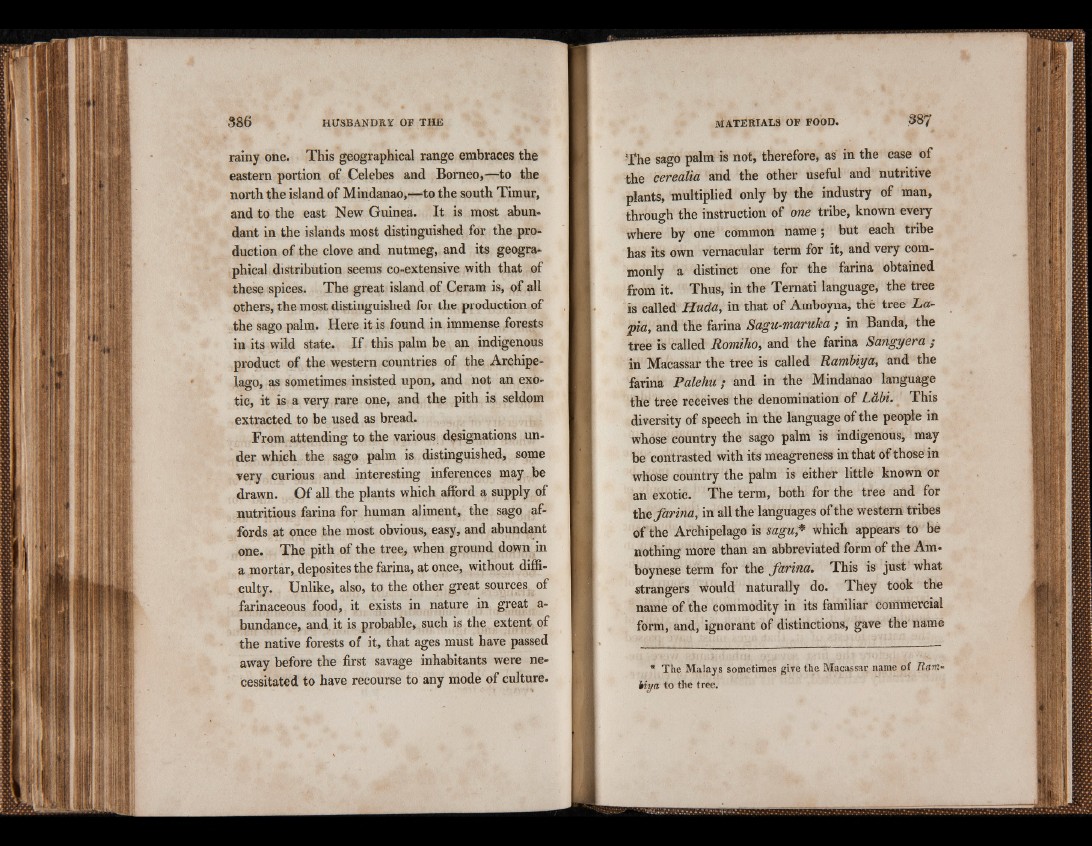
rainy one. This geographical range embraces the
eastern portion of Celebes and Borneo,—to the
north the island of Mindanao,—to the south Timur,
and to the east New Guinea. It is most abundant
in the islands most distinguished for the production
of the clove and nutmeg, and its geogra-
phical distribution seems co-extensive with that of
these spices. The great island of Ceram is, of all
others, the most distinguished for the production of
the sago palm. Here it is found in immense forests
in its wild state. If this palm be an indigenous
product of the western countries of the Archipelago,
as sometimes insisted upon, and not an exotic,
it is a very rare one, and the pith is seldom
extracted to be used as bread.
From attending to the various designations under
which the sago palm is distinguished, some
very curious and interesting inferences may be
drawn. Of all the plants which afford a supply of
nutritious farina for human aliment, the sago affords
at once the most obvious, easy, and abundant
one. The pith of the tree, when ground down in
a mortar, deposites the farina, at once, without difficulty.
Unlike, also, to the other great sources of
farinaceous food, it exists in nature in great a-
bundance, and, it is probable, such is the extent of
the native forests of it, that ages must have passed
away before the first savage inhabitants were necessitated
to have recourse to any mode of culture.
The sago palm is not, therefore, as in the case of
the cerealia and the other useful and nutritive
plants, multiplied only by the industry of man,
through the instruction of one tribe, known every
where by one common name ; but each tribe
has its own vernacular term for it, and very commonly
a distinct one for the farina obtained
from it. Thus, in the Ternati language, the tree
is called Huda, in that of Amboyna, the tree La-
pia, and the farina Sagu-maruka ; in Banda, the
tree is called Romiho, and the farina Sangyera ;
in Macassar the tree is called Rambiya, and the
farina Palehu / and in the Mindanao language
the tree receives the denomination of Labi. This
diversity of speech in the language of the people in
whose country the sago palm is indigenous, may
be contrasted with its meagreness in that of those in
whose country the palm is either little known or
an exotic. The term, both for the tree and for
the farina, in all the languages of the western tribes
of the Archipelago is sagu* which appears to be
nothing more than an abbreviated form of the Am*
boynese term for the farina. This is just what
strangers would naturally do. They took the
name of the commodity in its familiar commercial
form, and, ignorant of distinctions, gave the name
* The Malays sometimes give the Macassar name of Ram-
Uya to the tree.